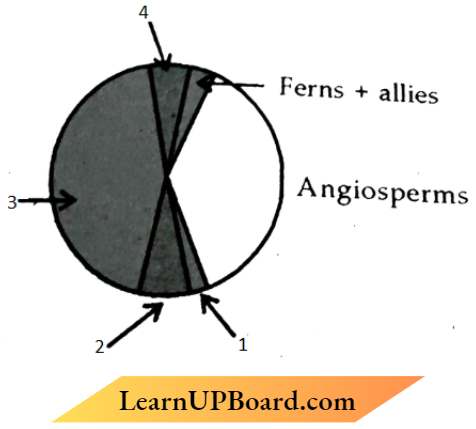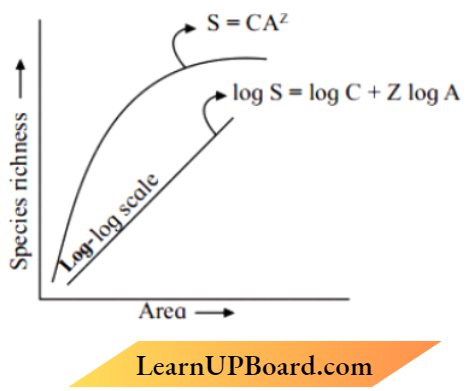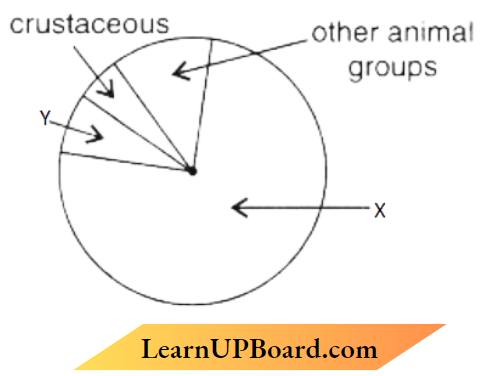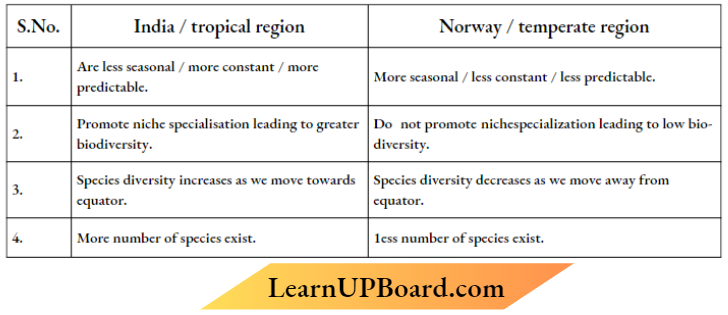Class 12 Biology Chapter 13 Important Questions Biodiversity And Conservation Short Question And Answer
Question 1. State ‘two’ observations made by German naturalist, Alexender von Humboldt during his extensive explorations in South American jungles.
Answer:
Within a region species richness increases with increasing explored area but only up to a limit, this relation for a wide variety of taxa turns out to be a rectangular hyperbola.
Question 2. Identify the areas labeled 1, 2, 3, and 4 in the pie chart given below representing the biodiversity of plants showing their proportionate number of species of major taxa.

Answer:
- Lichen
- Algae
- Fungi
- Mosses
Question 3. Suggest two practices giving one example of each, that help protect rare or threatened species.
Answer:
- In situ conservation, biodiversity hotspots biosphere reserves, national parks or sanctuaries, or Ramsar sites or sacred groves.
- Ex situ conservation. Zoological parks botanical gardens wildlife safari parks cryopreservation techniques Tissue culture seed bank or pollen banks.
Read and Learn More Important Questions for Class 12 Biology Chapter Wise
Question 4.
1. Write the inference drawn by Alexander von Humboldt after his extensive exploration of the South American jungle.
Answer:
German naturalist and geographer Alexander von Humboldt observed that within a region species richness increased with increasing explored area, but only up to a limit.
2. Study the graph given below

As per Alexander von Humboldt, what do the symbols S, A, Z, and C in the graph stand for, concerning a species and area relationship?
On a logarithmic scale, the relationship is a straight line described by the equation log S = log C + Z log A
where
S = Species richness A = Area
Z = Slope of the line (regression coefficient)
C = Y-intercept
Question 5.
1. Explain the concept of co-extinction by taking two examples.
Answer:
When a species becomes extinct, the plant and animal species associated with it in an obligator) way also become extinct Example: When a host fish species becomes extinct, its unique assemblage of parasites also meets the same fate. Another example is the case of a coevolved plant-pollinator mutualism where the extinction of one invariably leads to the extinction of the other.
2.”Forests provide intangible benefits to as.” Explain by taking three different areas, how.
Answer:
- Source of oxygen in the earth’s atmosphere,
- Pollination is another service provided by forests through different pollinators.
- Source of aesthetic pleasures (walking through thick woods or watching spring flowers in full bloom or waking up to Bulbul’s song in the morning),
- Humans derive countless economic benefits from nature – food (cereals, pulses, fruits),
- Source of firewood or fiber or construction material or industrial or industrial products (tannins or lubricants or dyes or resin perfumes).
Question 6. Study the pie chart given below, representing the global diversity: proportionate number of species of major taxa, and answer the following questions based on it.

- Identify ‘X’ and ‘Y’ in the given pie chart.
- Which one of the two, ‘X’ is the most species-rich taxonomic group, and by what percentage?
Answer:
X – Insects
Y – Molluscs
Among animals insects are the most species-rich taxonomic group, making up more than 70 percent of the total. That means, out of every 10 animals on this planet. 7 are insects.
Question 7. How have the following factors affected the biodiversity of an area? Explain.
- Habitat loss and fragmentation
- Over-exploitation
Answer:
- Habitat loss and fragmentation: This is the most important cause driving animals and plants to extinction. The most dramatic examples of habitat: loss come from tropical rainforests. The rainforests now cover no more than 6 percent. They are being destroyed fast and 1000 more hectares of rainforest would have been lost. The Amazon rain forest (‘lungs of the planet’) harboring probably millions of species is being cut and cleared for cultivating soya beans or for conversion to grasslands for raising beef cattle. Besides total loss, the degradation of many habitats by pollution also threatens the survival of many species, and certain animals with migratory habits are badly affected, leading’ population declines,
- Over-exploitation: Humans have always depended on nature for food and shelter, but when “need’ turns to ‘greed’, it leads to the over-exploitation of natural resources. Many species extinctions in the last 500 years (Steller’s sea cow, passenger pigeon) were due to overexploitation by humans. Presently many marine fish populations around the world are over-harvested, endangering the continued existence of some commercially important species.
Question 8. Study the graphical representation of Species richness – Area relationship is given below and answer the questions that follow :

1. What do S, C, Z, and A represent in the given graph?
Answer:
S = Species richness, A = Area,
Z = slope of the line (regression coefficient)
C = Y-intercept
2. What will be the range value of the ‘Z line’ if we analyze the species-area relationship among very large areas like the entire continent?
Z values in the range of 0.6 to 1.2
Question 9. Alien species invasion has been a threat to biodiversity. Justify with the help of a suitable example. List any other three causes responsible for such a loss.
Answer:
Example of Alien species invasion
- Nile Perch, introduced into Lake Victoria( in East Africa), led to the extinction of Cichlid fish (more than 200 species) in the lake
- Introduction of African catfish (Clarias gariepinus), for aquaculture, posing a threat to indigenous catfish
- Introduction of carrot grass (Parthcnium) Lantaua or Water hyacinth (lucrhornia), which are invasive weeds, that pose a threat to native species or any other appropriate example.
Causes of biodiversity loss
- Habitat loss and fragmentation
- Overexploitation
- Co-extinction
Question 10. Tigers inhabit forests. Over the past many decades, the tiger population has been on the decline in our country. A project ‘Save Tiger’ was launched in 1973 to conserve this precious species. It is heartening to see in the last couple of decades that there has been a gradual increase in the tiger population in our country.
Answer the questions :
1. Mention one major cause responsible for the decline in tiger population.
Answer:
Habitat loss and fragmentation or prey depletion.
2. Write one main effort of the biodiversity conservationists that must have helped in the increase in tiger population.
Answer:
Through in situ conservation like national parks or wildlife sanctuaries protect biodiversity hot spots or biosphere reserves or ex-situ conservation like zoological parks or zoos wildlife safari parks or cryopreservation,
3. State how it is possible to count the number of tigers in a forest area.
Answer:
Based on pug marks / faecal pellets/sites with scratches on trees chosen for installing camera/sinee each tiger has a very unique stripe pattern hence this is used to differentiate one tiger from the other.
Question 11. Analyze the effects of ‘Alien species invasion’ on the biodiversity of a given area. Provide two examples.
Answer:
- Introduction of alien species causes the decline or extinction of indigenous species due to tough home-tuition for utilization of resources Examples:
- The introduction of Nile perch in Lake Victoria led to the extinction of more than 200 species of Cichlid fish and the introduction of African catfish (Clarias) for aquaculture poses a threat to indigenous catfish.
- The threat posed to native species by invasive exotic weeds like carrot grass (Parthcnium)lantana and water hyacinth (Eichhornia) or Extinction of Abingdon tortoise by the introduction of goat, (any two).
Question 12. Explain the ‘Ex-situ conservation’ of Biodiversity. How is the in-situ conservation different from it?
Answer:
- Ex-site – Threatened animals and plants are taken out from their natural habitat and placed in special settings where they can be protected and given special care, by keeping the gametes of threatened species preserved in viable and fertile conditions for a long time.
- Zoological parks botanical gardens wildlife safari parks cryopreservation or eggs can be fertilized in-vitro or tissue culture method/seed banks.
- In-situ conservation, organisms are given protection in their natural habitat in which biodiversity is protected at all levels.
Class 12 Biology Chapter 13 Important Questions Biodiversity And Conservation Long Question And Answers
Question 1.
1. Identify the features of a stable biological community.
Answer:
- A stable community should not show too much variation in productivity from year to year.
- It must be either resistant or resilient to occasional disturbances (natural or man-made)
- It must also be resistant to invasions by alien species.
2. How did David Tilman’s findings link the stability of a biological community to its species richness?
Answer:
Plots with more species showed less year-to-year variation in total biomass increased diversity contributed to higher productivity.
Question 2.
1.”India has greater ecosystem diversity than Norway.” Do you agree with the statement? Give reasons in support of your answer.
Answer:
Yes

2. Write the difference between genetic biodiversity and species biodiversity that exists at all levels of biological organization.
Answer:
Genetic diversity – Diversity or variation within a species over its distributional range example, 1000 vanities of mango in India.
Species diversity – Diversity or variation at a species level example, Amphibian diversity in the western ghat.
